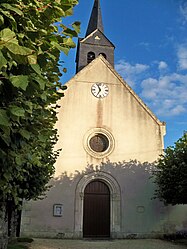Senneçay
Senneçay | |
|---|---|
 The church in Senneçay | |
 Coat of arms | |
 Senneçay | |
| Coordinates: 46°57′07″N 2°26′16″E / 46.9519°N 2.4378°ECoordinates: 46°57′07″N 2°26′16″E / 46.9519°N 2.4378°E | |
| Country | France |
| Region | Centre-Val de Loire |
| Department | Cher |
| Arrondissement | Bourges |
| Canton | Trouy |
| Intercommunality | CC Le Dunois |
| Government | |
| • Mayor (2020–2026) | Irène Thibault |
| Area 1 | 14.47 km2 (5.59 sq mi) |
| Population (Jan. 2018)[1] | 471 |
| • Density | 33/km2 (84/sq mi) |
| Time zone | UTC+01:00 (CET) |
| • Summer (DST) | UTC+02:00 (CEST) |
| INSEE/Postal code | 18248 /18340 |
| Elevation | 154–181 m (505–594 ft) (avg. 172 m or 564 ft) |
| 1 French Land Register data, which excludes lakes, ponds, glaciers > 1 km2 (0.386 sq mi or 247 acres) and river estuaries. | |
Senneçay (French pronunciation: [sɛnsɛ]) is a commune in the Cher department in the Centre-Val de Loire region of France.
Geography[]
Senneçay is a farming village situated about 10 miles (16 km) south of Bourges, at the junction of the D46 and the D34 roads. The A71 autoroute forms the commune’s western border.
Population[]
| Year | Pop. | ±% |
|---|---|---|
| 1962 | 305 | — |
| 1968 | 328 | +7.5% |
| 1975 | 288 | −12.2% |
| 1982 | 258 | −10.4% |
| 1990 | 347 | +34.5% |
| 1999 | 345 | −0.6% |
| 2008 | 435 | +26.1% |
Sights[]
- The church of St. Pierre, dating from the thirteenth century.
See also[]
- Communes of the Cher department
References[]
- ^ "Populations légales 2018". The National Institute of Statistics and Economic Studies. 28 December 2020.
| Wikimedia Commons has media related to Senneçay. |
Categories:
- Communes of Cher (department)


